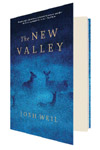The men who inhabit The New Valley live in the cold shadows of the Blue Ridge Mountains, a range known by that name because of how the mountains look, during a certain light, from afar. Dotting the valley are towns named Coalsburg, Harts Run, and Narrows; it’s “a place of homes scattered far from homes, and meant to be that way, of lives built around cattle more than conversation.” It’s rutted, sedate, and out-of-the-way, a setting suited for exploring the lives of three lonely men and the losses they bear. One would think Weil’s outsider protagonists, who live within such close proximity, might know one another, but their only connections are the distances between each other and the untamed land.
In these three beautiful novellas, the sky above and the soil below bear witness to stories so elemental and stunningly intricate that they seem carved from hickory. Weil carefully roots out these men from their hiding places, watching over his flock of lost souls with unbounded empathy.
The “mountain-raised, long-working, hard-minded, fear-driven” Stillman Wing, of the novella that shares his name, has a face that’s “a crag of corners and crevices with eyes as dark and deep as spring water pooled in caves.” In his seventies, Stillman tries to resurrect a broken Deutz tractor, practices chi gong to keep his bones steady, and worries about his promiscuous, “barrel thigh[ed]” daughter, who moves out to live on a nearby commune. The commune is the only hive of community that exists, it seems, in these parts. Weil arranges poetry out of Stillman’s quiet, stubborn pain—“the sound of the mailman’s truck… his only company”—and baptizes his character in redemptive waters.
In “Ridge Weather,” a middle-aged buck named Osby, orphaned after his father’s suicide, is left to care for the family’s time-beaten farm. Crushed by loneliness, Osby talks to himself, and the cows, to comfort his disquieted heart. He hops aboard a school bus that drives the country roads, so heart-wrenchingly beaten down that the touch of a human hand might burn him. Throughout, Osby cares for a one-balled steer downed by “grass tetany” and accidentally injects life back into the steer’s, and his own.
It’s hard sculpting beauty out of so much mud. Writing about plain-mouthed, flawed, of-the-earth characters requires understanding, much compassion, and a kind heart. Weil summons this compassion once more in the final novella, “Sarverville Remains,” raising the voice of Geoffrey Sarver, a “diminished” man rumored to be from a town once populated by hill people. Geoff falls hard for a trickster woman with her own, selfish designs. Strangely, she offers blow jobs to Geoff and his friends while on break from her waitressing job. It’s all a mystery, told through the mildly retarded man’s letters to the woman’s husband. The dialect—“Them first weeks way back in spring before it all gone bad”—gives the story pulse and makes the briar and hay and tobacco leaves around him hum. Eventually, the mystery of the woman is solved, and Geoff, the fundamental outsider, finds his bearings close to the earth, comforted by the safety of dilapidation. Where he ends up, only the land remains, a survivor that gives voice to those without, to those entombed on forgotten hillsides, to those orphaned and tending calves and tractors, reminding us that no matter how isolated, how lonely, tender hearts burn everywhere, they burn bright, and they burn on.





